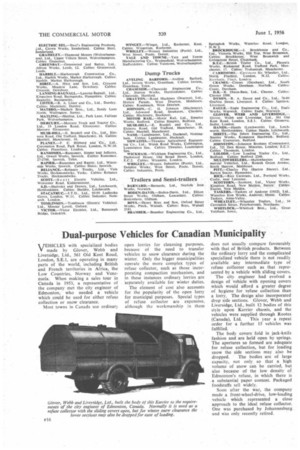Dual-purpose Vehicles for Canadian Municipality •
Page 114

If you've noticed an error in this article please click here to report it so we can fix it.
VEHICLES with specialized bodies made by Glover, Webb and Liversidge, Ltd., 561 Old Kent Road, London, SE.!, are operating in many parts of the world, including British and French territories in Africa, the Low Countries, Norway and Venezuela. When making a sales tour in Canada in 1953, a representative of the company met the city engineer of Edmonton, who needed a vehicle which could be used for either refuse collection or snow clearance.
Most towns in Canada use ordinary open lorries for cleansing purposes, because of the need to transfer vehicles to snow clearance during the winter. Only the bigger municipalities operate the more complex types of refuse collector, such as those incorporating compaction mechanism, and in these instances ordinary lorries arc separately available for winter duties.
The element of cost also accounts for the popularity of the open lorry for municipal purposes. Special types of refuse collector are expensive, although the workmanship in them does not usually compare favourably with that of British products. Between the ordinary lorry and the complicated specialized vehicle there is not readily available any intermediate type of refuse collector such as that represented by a vehicle with sliding covers.
The city engineer had evolved a design of vehicle with opening covers which would afford a greater degree of hygiene for refuse collection than a lorry. The design also incorporated drop side sections. Glover, Webb and Liversidge, Ltd., built 12 bodies of this style upon Karricr chassis, and the vehicles were supplied through Rootes (Canada), Ltd, This year a repeat order for a further 15 vehicles was fulfilled.
The body covers fold in jack-knife fashion and are held open by springs. The apertures so formed are adequate for refuse collection, but for loading snow the side sections may also be dropped. The bodies are of large capacity, not only so that a high volume of snow can be carried, but also because of the low density of Edmonton's refuse, in which there is a substantial paper content. Packaged foodstuffs sell widely.
Soon after the war, the company made a front-wheel-drive, low-loading vehicle which represented a close approach to the ideal refuse collector. One was purchased by Johannesburg and Was only recently retired.




























































































































































































































































